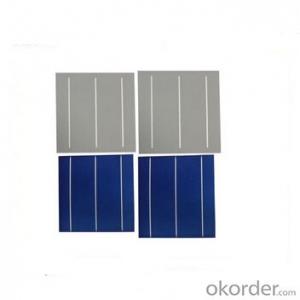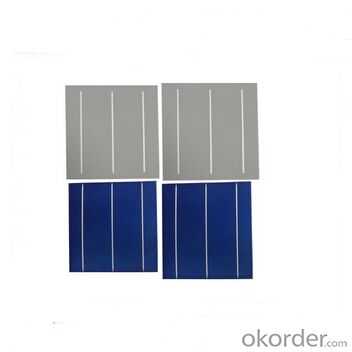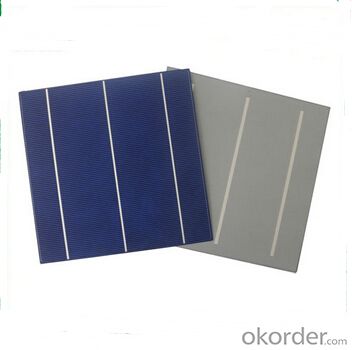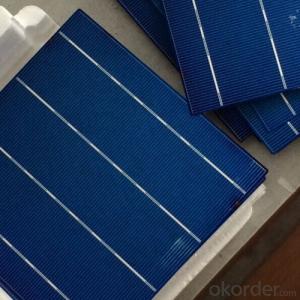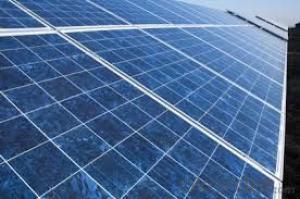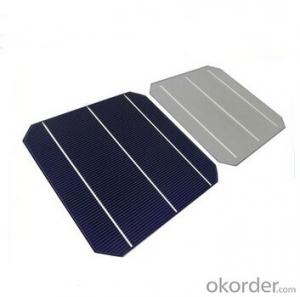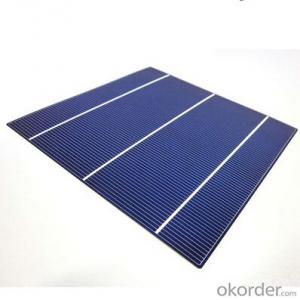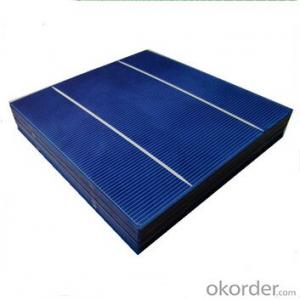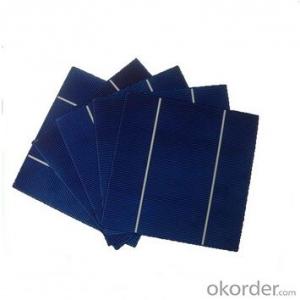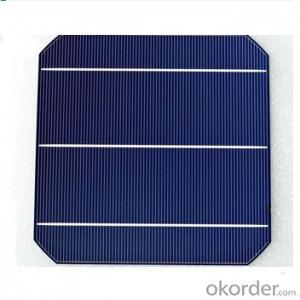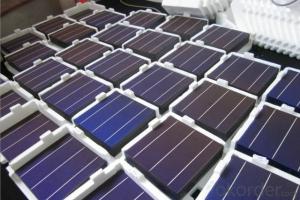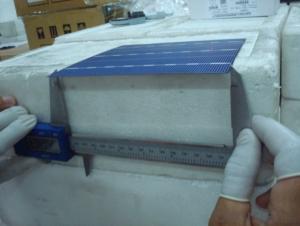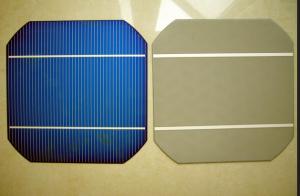High Quality Polycrystalline Solar Cell 190um ± 20um - Cost of Silicon Solar Cells
- Loading Port:
- Shanghai
- Payment Terms:
- TT OR LC
- Min Order Qty:
- 1000 pc
- Supply Capability:
- 1000000 pc/month
OKorder Service Pledge
OKorder Financial Service
You Might Also Like
Solar Cells:
solar cells, when struck by photons of light from the sun, generates an electrical current which can then be used to power DC or AC electrical loads.
A solar cell is made of silicon. Computer chips are made of this same material. Basically, when light strikes the surface of a solar cell some of it is absorbed into the silicon. This light energy bumps the electrons loose and causes energy to flow
Solar cells is made by solar wafer, it has three categories of solar cell right now, monocrystalline polycrystalline and thin film,These cells are entirely based around the concept of PN junction, which is the critical part of solar module, it is the part that can convert the light energy into electricity, the thickness is from 180um to 200um, with even busbars to conduct electricity, textured cell can decrease diffuse reflection; they are often electrically connected and encapsulated as a module. Photovoltaic modules often have a sheet of glass on the front (sun up) side, allowing light to pass while protecting semiconductor wafers from abrasion and impact due to wind-driven debris, rain, hail, etc. Solar cells are also usually connected in series in modules, creating an additive voltage. Connecting cells in parallel will yield a higher current;With high quality and stable quality. Our Cells can greatly improve the performance of Solar Modules.
Specifications
Efficiency (%) | Pmpp (W) | Voc (V) | Isc (A) | Imin (A) |
18.6 | 4.53 | 0.637 | 8.84 | 8.53 |
18.4 | 4.48 | 0.635 | 8.81 | 8.48 |
18.2 | 4.43 | 0.633 | 8.77 | 8.43 |
18 | 4.38 | 0.631 | 8.73 | 8.38 |
17.8 | 4.33 | 0.629 | 8.69 | 8.33 |
17.6 | 4.28 | 0.627 | 8.65 | 8.27 |
17.4 | 4.23 | 0.624 | 8.61 | 8.22 |
17.2 | 4.19 | 0.621 | 8.56 | 8.16 |
Features:
High efficiencies up to 16.4%
Proven long term mechanical stability of silicone
Make of highly purified poly silicone
Three bus bars for reduced series resistance and improved module and cell efficiency
Blue anti-reflecting coating ensures improved light absorption and increased efficiency
Acid texturization offers a uniform appearance and virtually invisible crystal structure
Excellent low light behavior for improved energy yield
Solar Cells Advantage:
• High efficiency and stable performance in photovoltaic conversion.
• Advanced diffusion technique ensuring the homogeneity of energy conversion efficiency of the cell.
• Advanced PECVD film forming, providing a dark blue silicon nitride anti-reflection film of homogenous color and attractive appearance.
• High quality metal paste for back surface and electrode, ensuring good conductivity, high pulling strength and ease of soldering.
• High precision patterning using screen printing, ensuring accurate busbar location for ease with automatic soldering a laser cutting.
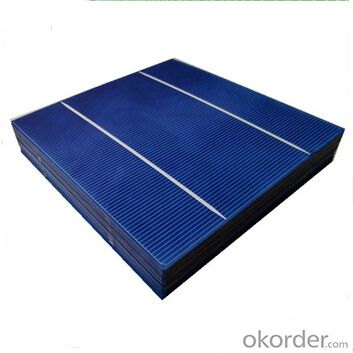
FAQ
We have organized several common questions for our clients,may help you sincerely:
①What price for each watt?
It depends on the efficiency of the solar cell, quantity, delivery date and payment terms.
②How long can we receive the product after purchase?
In the purchase of product within three working days, We will arrange the factory delivery as soon as possible. The pecific time of receiving is related to the state and position of customers.Commonly 7 to 10 working days can be served.
③Can you provide the peripheral products of the solar panels, such as the battery, controller, and inverter? If so, can you tell me how do they match each other?
Yes, we can, we have two companies for solar region, one is CNBM International, the other is CNBM engineering Co.
We can provide you not only the solar module but also the off grid solar system, we can also provide you service with on grid plant.
④What is your warranty of solar cell?
Our product can promise lower than 0.3% open box crack, we support claim after opening the box if it has crackm color difference or sth, the buyer should give pictures immediately, we can not accept the claim after the solar cell has assembled to solar panel.
• Timeliness of delivery
• ⑤How do you pack your products?
We have rich experience on how to pack the solar cell to make sure the safety on shipment, we could use wooden box or pallet as buyer's preference.
- Q: How do solar cells perform in regions with high levels of salt spray and corrosive environments?
- Solar cells generally do not perform well in regions with high levels of salt spray and corrosive environments. The salt particles can accumulate on the surface of the solar cells, leading to reduced efficiency and decreased performance. Additionally, the corrosive nature of the environment can cause damage to the materials and components of the solar cells, further impacting their functionality. To mitigate these issues, special protective coatings or materials can be used to enhance the durability and resistance of solar cells in such regions.
- Q: Can solar cells be used for powering outdoor surveillance systems?
- Yes, solar cells can be effectively used for powering outdoor surveillance systems. Solar cells convert sunlight into electricity, providing a reliable and sustainable source of power for surveillance cameras, sensors, and other surveillance system components. This eliminates the need for conventional power sources and reduces the costs associated with connecting to the electrical grid. Additionally, solar-powered surveillance systems can be easily installed in remote or off-grid locations, making them highly flexible and efficient for outdoor surveillance applications.
- Q: Can solar cells be used for powering electric vehicles charging stations?
- Yes, solar cells can be used to power electric vehicle charging stations. Solar panels can convert sunlight into electricity, which can then be used to charge electric vehicles. This helps to utilize renewable energy sources and reduce the carbon footprint associated with charging electric vehicles.
- Q: Which one is better on the solar cells panel? The Monocrystal Solar Energy Cell or photovoltaic cell?
- The photovoltaic cell is better in collecting the sunlight, which means it will be more efficient when the sunlight is better.
- Q: Can solar cells be used for powering sports stadiums?
- Yes, solar cells can be used for powering sports stadiums. They have the ability to generate electricity from sunlight and can be installed on the roof or surrounding areas of the stadium. This renewable energy source can help reduce the carbon footprint of the stadium and contribute to a more sustainable and environmentally friendly power supply.
- Q: What are the main components of a solar cell?
- The main components of a solar cell are a semiconductor material, typically silicon, which absorbs sunlight and generates electricity; metal contacts that collect and carry the generated electricity; and a protective layer, usually made of glass or plastic, to shield the semiconductor material from external factors.
- Q: How do solar cells perform in regions with high levels of dust and sandstorms?
- Solar cells may experience decreased performance in regions with high levels of dust and sandstorms. The accumulation of dust particles on the surface of solar panels can reduce their efficiency by blocking sunlight and reducing the amount of energy they can generate. Regular cleaning and maintenance of solar panels are essential in such environments to ensure optimal performance. Additionally, advancements in solar panel technology, such as anti-soiling coatings, are being developed to mitigate the impact of dust and sandstorms on solar cell performance.
- Q: Solar cells and the difference between ordinary batteries. Why is the solar cell is converted into electrical energy, zinc battery is what is converted into chemical energy
- Ordinary batteries have a certain life, can not be stored for too long, or the power will slowly run out of solar cells do not exist chemical failure, can be long-term preservation.
- Q: Are solar cells affected by shade or partial shading?
- Yes, solar cells are significantly affected by shade or partial shading. Even a small amount of shade on a solar cell or panel can greatly reduce its overall efficiency and power output. This is because shading disrupts the flow of sunlight, preventing certain areas of the cell from receiving direct sunlight and therefore generating less electricity. It is important to ensure that solar panels are installed in areas with minimal shade to maximize their performance.
- Q: Can solar cells be used for powering satellites?
- Yes, solar cells can be used for powering satellites. Solar cells are often used as the primary power source in satellites due to their ability to convert sunlight into electricity. The solar cells are typically mounted on the satellite's surface to capture sunlight and generate power for various systems and instruments onboard.
Send your message to us
High Quality Polycrystalline Solar Cell 190um ± 20um - Cost of Silicon Solar Cells
- Loading Port:
- Shanghai
- Payment Terms:
- TT OR LC
- Min Order Qty:
- 1000 pc
- Supply Capability:
- 1000000 pc/month
OKorder Service Pledge
OKorder Financial Service
Similar products
Hot products
Hot Searches
Related keywords
